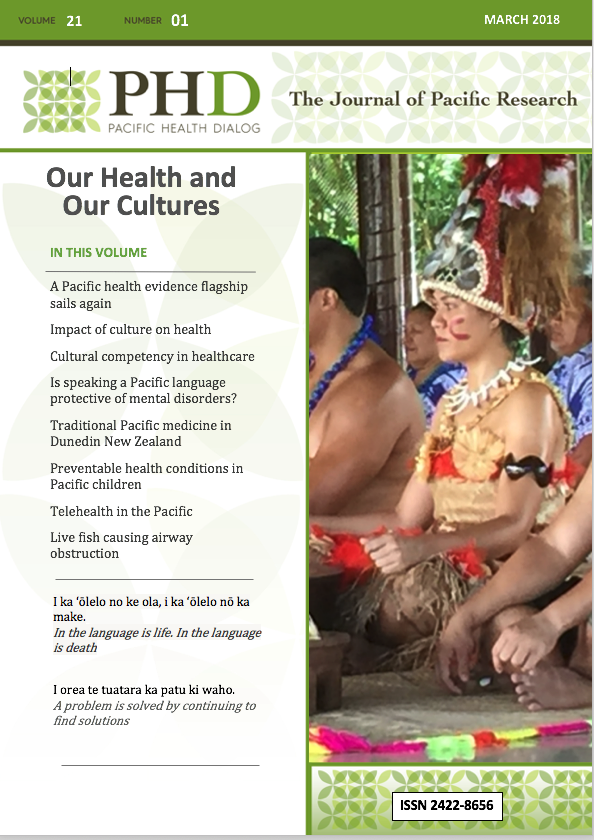Traditional Medicine Use in the Dunedin Pacific Community in New Zealand
Main Article Content
Keywords
Traditional medicine = TM, Pacific health, Pacific medicine, alternative medicine, complimentary alternative medicine, traditional plants, traditional healing
Abstract
Background: Traditional medicine (TM) has been practiced in the Pacific islands over many years, and Pacific peoples continue to use TM after migrating to New Zealand (NZ). There is limited published literature on Pacific TM use in NZ. This study explores the views, use of, and access to TM of Pacific Peoples living in Dunedin, NZ. The information provides a valuable contribution in an important area where there is a paucity of information, and will also inform content development for the Pacific health curriculum for health professional courses at the University of Otago.
Methods: Cultural processes were used to inform and guide the recruitment of participants and data collection phases. Four focus groups were conducted with 15 Pacific Island community members. Interviews were recorded, transcribed and analysed using an inductive approach to identify main themes.
Results: Three main themes emerged from the data: Firstly, perspectives of TM from Pacific peoples, was varied and included the importance of spirituality, the environment and inherited knowledge. Secondly, the use of TM which incorporated plants, massage, diet, family togetherness and other forms of healing. Reasons for the use and differences in uptake between groups were also identified. The last main theme identified was barriers in accessing TM, that included the scarcity of traditional healers, resources, and cost.
Conclusion: The findings suggest Pacific peoples’ perspectives of TM encompassed a wide spectrum of views, knowledge and techniques. There were identified barriers in access and substitution where traditional ingredients were not available. Some expressed concern that TM use may decline due to loss of exposure and availability of resources. Other challenges are fewer traditional healers and relevant plants in New Zealand. Assisting Western health professionals to engender discussion and openness to TM use in Pacific Peoples is likely to support patient care.
References
2. Abdullahi AA. Trends and challenges of traditional medicine in Africa. Afr J Tradit Complement Altern Med. 2011;8(5 Suppl):115-23.
3. World Health Organization. Traditional Medicine: Definitions. Available from http://www.who.int/traditional-complementary-integrative-medicine/about/en/. Accessed 10 November 2017.
4. Pledger MJ, Cumming JN, Burnette M. Health service use amongst users of complementary and alternative medicine. N Z Med J. 2010;123(1312):26.
5. Bodeker G, Burford G, Volk A. Integrative, Traditional and Complementary Medicine. Reference Module in Biomedical Sciences: Elsevier; 2017.
6. Sofowora A. Research on medicinal plants and traditional medicine in Africa. J Altern Complement. 1996;2(3):365.
7. Xue CC, Zhang AL, Lin V, Da Costa C, Story DF. Complementary and alternative medicine use in Australia: a national population-based survey. J Altern Complement Med. 2007;13(6):643-50.
8. Posadzki P, Watson LK, Alotaibi A, Ernst E. Prevalence of use of complementary and alternative medicine (CAM) by patients/consumers in the UK: systematic review of surveys. Clin Med (Lond). 2013;13(2):126-31.
9. Ock SM, Choi JY, Cha YS, Lee J, Chun MS, Huh CH, et al. The use of complementary and alternative medicine in a general population in South Korea: results from a national survey in 2006. J Korean Med Sci. 2009;24(1):1-6.
10. Wetzel MS, Eisenberg DM, Kaptchuk TJ. Courses involving complementary and alternative medicine at US medical schools. JAMA. 1998;280(9):784-7.
11. Gale N. The Sociology of Traditional, Complementary and Alternative Medicine. Sociol Compass. 2014;8(6):805-22.
12. Poynton L, Dowell A, Dew K, Egan, T. General practitioners' attitudes toward (and use of) complementary and alternative medicine: a New Zealand nationwide survey. NZ Med J. 2006;119:1247.
13. Krosch, SL. Perceptions and use of complementary and alternative medicine in American Samoa: a survey of health care providers. Hawaii Med J. 2010;69(6 Suppl 3): 21.
14. Statistics New Zealand. 2016. National Pacific Projections. Available from http://www.stats.govt.nz.
15. Sundborn G, Taylor S, Tautolo el S, Finau S. Utilisation of Traditional Pacific Healers by mothers and children of the Pacific Islands Families Study. Pac Health Dialog. 2011;17(2):105-18.
16. Finau, S. Traditional health practices in a modern Pacific: a dilemma or blessing? N Z Med J. 1994;107(970): 14.
17. Ghiasuddin A, Wong J, Siu AM. Ethnicity, traditional healing practices, and attitudes towards complementary medicine of a pediatric oncology population receiving healing touch in Hawaii. Asia Pac J Oncol Nurs. 2015;2(4):227-31.
18. Pulotu-Endemann FK. Fonofale Model of Health. 2001. Auckland. Available from http://www.hauora.co.nz/resources/Fonofalemodelexplanation.pdf. Accessed 10 November 2017.


